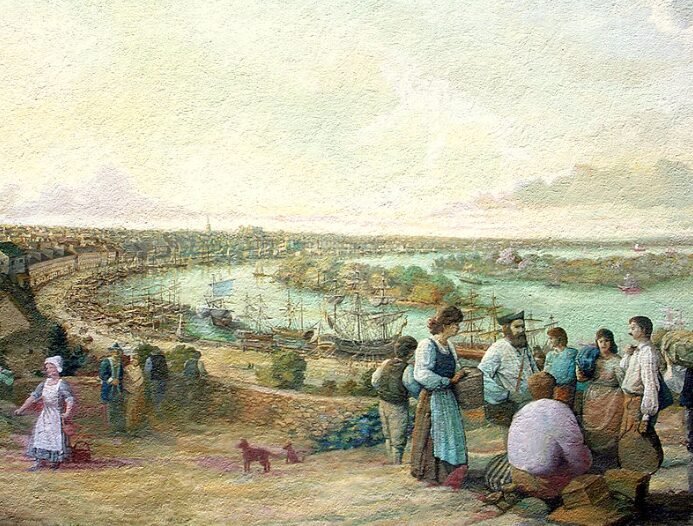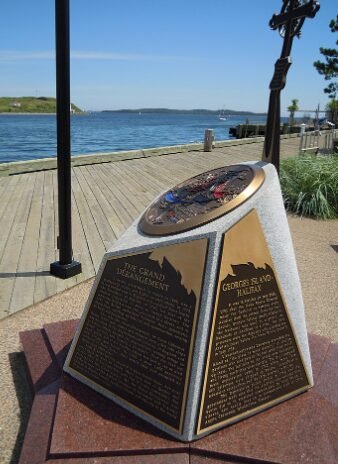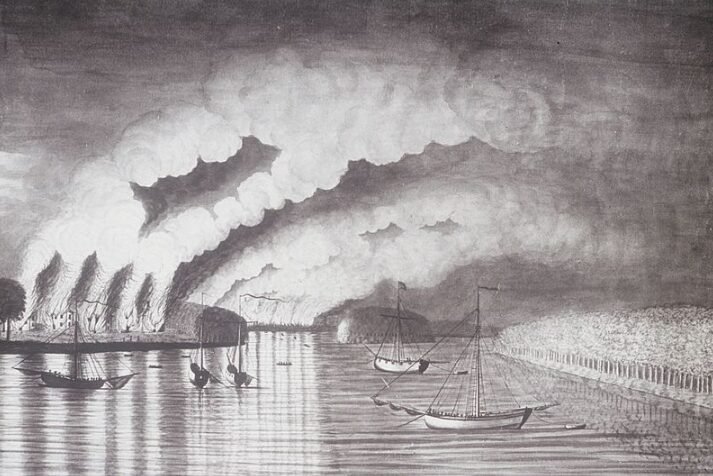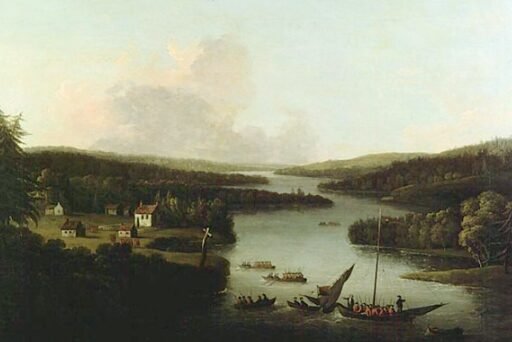The Acadian Expulsion: When did it occur, and what triggered it?

The Acadian Expulsion began, with British officer John Winslow rounding up 5,000 Acadians in Nova Scotia. This forced relocation came after the Acadians refused to swear allegiance to the British Crown, and many of those expelled eventually settled in Louisiana. Image: Mémorial des Acadiens de Nantes
The Acadian Expulsion, or Le Grand Dérangement (1755-1764), was one of the most tragic and pivotal events in Canadian and North American history. It involved the forced removal of the Acadian people from the Maritime provinces of Canada, primarily Nova Scotia, by the British.
The Acadians, who were of French descent, had settled in the region since the early 17th century. They lived relatively isolated lives in the Bay of Fundy area, largely farming, and creating a distinct community with their own language, religion, and culture.
However, their neutrality in the conflicts between the British and the French would eventually lead to their downfall. Below is a detailed history of the event, its causes, and its aftermath.
Early Acadian Settlement
The origins of the Acadians date back to the early 1600s when French settlers arrived in the region of Acadia, which included parts of present-day Nova Scotia, New Brunswick, and Prince Edward Island. The first French settlement, Port Royal, was established in 1605. The Acadians, though subjects of the French Crown, developed a unique identity over the years, distinct from the French settlers of Quebec. They cultivated the rich lands around the Bay of Fundy, employing a system of dykes to create farmland from the marshy coastline. The Acadians built prosperous agricultural communities and lived in relative harmony with the local Mi’kmaq people.
The region of Acadia changed hands several times between the French and the British due to various European conflicts. By the early 18th century, Acadia had officially come under British control with the signing of the Treaty of Utrecht in 1713. Despite this, the Acadian population remained predominantly French-speaking and Catholic, while the British were Protestant. Tensions between the British and the Acadians would slowly mount as the British sought to secure loyalty from the Acadians in their struggle with the French Empire.
Causes of the Expulsion
By the mid-18th century, the relationship between Britain and France was tense, culminating in the Seven Years’ War (1756–1763), a global conflict in which the two nations fought for control of North America. In this broader context, the British viewed the Acadians with suspicion. The Acadians had declared themselves neutral in the ongoing disputes between the French and the British. They refused to take an unconditional oath of allegiance to the British Crown, largely due to their desire to remain neutral and the possibility that they might be forced to fight against the French or their Mi’kmaq allies.
The British, led by Governor Charles Lawrence of Nova Scotia, viewed this refusal as a potential threat. The concern was that if war broke out with France, the Acadians, who were still ethnically French, might align with their former countrymen and pose a military threat from within. Thus, the British began to view the removal of the Acadians as a necessary measure to secure their control over the region.
In 1755, tensions reached a breaking point. Governor Lawrence, without approval from the British government, ordered the mass deportation of Acadians. This expulsion was aimed at removing the perceived threat of a French uprising and redistributing Acadian lands to British settlers. The Acadians were not given time to prepare or resist.

British Army officer and Governor, Charles Lawrence
The Expulsion
On September 5, 1755, the British authorities summoned Acadian men from several communities to a meeting at Fort Beauséjour (located in present-day New Brunswick). There, they were informed that their lands, homes, and possessions were forfeited to the British Crown and that they and their families would be deported immediately. The Acadians were rounded up, and many were held in makeshift prisons while awaiting transport.
The deportations took place over several years, and tens of thousands of Acadians were forcibly removed from their homes. Families were often separated, and many were placed on overcrowded ships, which led to the deaths of thousands due to disease and harsh conditions. Some ships were lost at sea, further compounding the tragedy. The British shipped the Acadians to various destinations, including the American colonies, England, and France. Many Acadians also ended up in the Caribbean, while others made their way to Louisiana, where they became known as Cajuns.
While the initial expulsion occurred in 1755, further waves of deportation continued over the next decade. Acadians who had managed to escape the initial wave or had returned to their homes were rounded up and sent away. Acadian settlements were systematically destroyed, and their lands were confiscated and redistributed to British settlers, known as the New England Planters.

Deportation of the Acadians, Grand-Pré
Aftermath and Legacy
The Acadian Expulsion had devastating effects on the Acadian population. Of the estimated 14,000 to 18,000 Acadians living in the Maritimes before the expulsion, approximately 11,500 were deported, and thousands died during the ordeal. The Acadian society, which had flourished for over a century, was almost entirely dismantled.
Despite the attempts to destroy the Acadian presence in the region, many Acadians eventually found their way back to the Maritimes. In the years following the end of the Seven Years’ War and the signing of the Treaty of Paris in 1763, some Acadians were allowed to return to Nova Scotia, New Brunswick, and Prince Edward Island. However, they were not allowed to settle in their former lands, and many ended up in more remote areas. Over time, the Acadians rebuilt their communities, and their culture and language survived.
One of the most enduring legacies of the Acadian Expulsion is the strong sense of identity among Acadian descendants. Despite the trauma of deportation and the loss of their lands, the Acadians maintained their language, religion, and traditions. Today, Acadian culture thrives in parts of the Maritime provinces, particularly in New Brunswick, where French is one of the official languages.
The expulsion also led to the creation of a new cultural group in Louisiana. The Acadians who settled there became known as Cajuns, and their descendants continue to contribute to the rich cultural tapestry of Louisiana through their language, music, food, and traditions.

Image: Monument to Imprisoned Acadians on Georges Island (background), Bishops Landing, Halifax
Major Facts About the Acadian Expulsion

Image: St. John River Campaign: “A View of the Plundering and Burning of the City of Grimross” (1758) Watercolor by Thomas Davies
- Population Displacement: The Acadian Expulsion involved the forced removal of around 11,500 Acadians, out of a population of 14,000 to 18,000, from their homeland between 1755 and 1764.
- Primary Cause: The British feared that the Acadians, due to their French heritage and refusal to pledge unconditional loyalty to the British Crown, might side with France in the event of war.
- Execution of Expulsion: The expulsion was carried out under the orders of British Governor Charles Lawrence. Acadians were rounded up, imprisoned, and transported by ships to various destinations, often in brutal conditions.
- Destinations: Acadians were deported to American colonies, France, the Caribbean, and England. Some eventually made their way to Louisiana, where they became known as Cajuns.
- Deaths During Deportation: Thousands of Acadians died during the deportation due to disease, shipwrecks, and poor living conditions aboard the overcrowded ships.
- Destruction of Settlements: British authorities destroyed Acadian homes, churches, and farms, erasing much of their physical presence in the region.
- Return of Acadians: After the end of the Seven Years’ War in 1763, some Acadians were allowed to return to the Maritimes, but they were not permitted to settle in their original lands.
- Cultural Survival: Despite the expulsion, Acadian culture survived and thrives today in parts of the Maritime provinces and Louisiana.
- Cajun Identity: The deported Acadians who settled in Louisiana developed a unique cultural identity, now known as Cajun, which has contributed significantly to Louisiana’s cultural heritage.
- Official Apology: In 2003, the Canadian government issued a formal apology to the Acadian people for the expulsion. The date of July 28 was designated as a National Day of Remembrance for the Acadian Expulsion.
- Cultural Symbolism: The Acadian Expulsion has become a powerful symbol of cultural resilience and survival, with Acadian communities today celebrating their heritage through festivals, music, and language preservation efforts.
Conclusion
The Acadian Expulsion, one of the darkest chapters in Canadian history, had long-lasting repercussions not only for the Acadians themselves but also for the regions where they resettled. The Acadian people were forcibly uprooted from their lands, their communities were scattered, and their culture faced extinction. However, despite this adversity, the Acadian spirit endured. Today, both Acadians and Cajuns stand as a testament to the resilience of cultural identity in the face of great hardship, and their influence continues to be felt in Canada, Louisiana, and beyond.
Questions and Answers

The Expulsion of the Acadians, also known as Le Grand Dérangement, was the forced removal of the Acadian population from the region of Acadia between 1755 and 1764 by the British. Image: Raid on Miramichi Bay – Burnt Church Village by British army officer Captain Hervey Smythe (1758)
Which regions did Acadia encompass?
Acadia included present-day Nova Scotia, New Brunswick, Prince Edward Island, and parts of Maine.
During which war did the expulsion occur?
The expulsion occurred during the French and Indian War, the North American theater of the Seven Years’ War.
Where were the Acadians deported initially?
Initially, the Acadians were deported to the Thirteen Colonies. From 1758 onward, they were sent to Britain and France.
How many Acadians were forcibly removed, and how many died during the expulsion?
Of the approximately 14,100 Acadians, around 11,500 were forcibly removed, and 5,000 died from disease, starvation, or shipwrecks.
What happened to the Acadian lands after their expulsion?
The Acadian lands were seized and redistributed to settlers loyal to the British Crown, primarily from New England and Scotland.
Why do historians debate whether the Expulsion of the Acadians constitutes genocide?
While the expulsion is widely regarded as a crime against humanity, the use of the term “genocide” is debated because scholars differ on whether it meets the criteria of systematic extermination of a group.
How many Acadians remained in the region after the expulsion, according to the 1764 census?
According to a 1764 census, around 2,600 Acadians remained in the region, having eluded capture.
How did the British come to control Acadia?
The British captured Port Royal, Acadia’s capital, in 1710 during the War of the Spanish Succession, and the Treaty of Utrecht in 1713 formally ceded the territory to Britain.
Why were the British suspicious of the Acadians?
The Acadians were reluctant to sign an unconditional oath of allegiance to Britain, and some supported French military efforts, helping supply lines to French fortresses like Louisbourg and Beauséjour.
What action did British Governor Charles Lawrence take regarding the Acadians?
In 1755, Governor Charles Lawrence and the Nova Scotia Council ordered the expulsion of all Acadians, without differentiating between those who were neutral and those involved in French military activities.
Where did some Acadians flee after the expulsion orders?
Some Acadians fled to Francophone colonies such as Canada, the uncolonized northern part of Acadia, Île Saint-Jean (now Prince Edward Island), and Île Royale (now Cape Breton Island).
What were the British military objectives achieved through the expulsion?
The British weakened the Mi’kmaq and Acadian militias and destroyed the French fortress of Louisbourg.
How many Acadians died during the expulsion, and from what causes?
Thousands of Acadians died during the expulsions, mainly from diseases and drowning when ships were lost.
What order did the British government issue in 1764 regarding the Acadians?
On July 11, 1764, the British government allowed Acadians to return to British territories in small, isolated groups if they took an unconditional oath of allegiance.
Where do Acadians primarily live today?
Today, Acadians primarily live in eastern New Brunswick, as well as parts of Prince Edward Island, Nova Scotia, Quebec, and northern Maine.
How was the Acadian Expulsion memorialized in literature?
The Acadian Expulsion was memorialized in Henry Wadsworth Longfellow’s 1847 poem Evangeline, which spread awareness of the tragedy through the story of a fictional character’s plight.



























